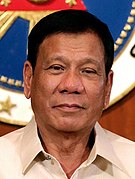DuterteNomics

DuterteNomics refers to the socioeconomic policies of President Rodrigo Duterte. A siginificant part of the policy includes the development of infrastructure and industries.[1]
Background
Finance secretary Carlos Dominguez has said that the government required what he describes as a "audacious" economic strategy in order for the Philippines to "catch up with its more vibrant neighbors" by 2022 and help it achieve high-income economy status within a generation. The term "DuterteNomics" was coined to describe the economic policy of the Duterte administration. The term also refers to the series of forum where Duterte's economic team pitches the administration's plan to help the country become a high middle-income economy by 2022.[2]
The policy was unveiled on April 18, 2017 by the Department of Finance and the Presidential Communications Operations Office (PCOO), in cooperation with the Center for Strategy, Enterprise and Intelligence (CenSEI) in a forum held at Conrad Manila in Pasay. A second forum was held on April 25, 2017.[2]
DuterteNomics was also pitched abroad particularly at the 2017 World Economic Forum on the Association of Southeast Asian Nations in Cambodia and at the sidelines of the 2017 One Belt One Road Forum for International Cooperation in Beijing, China.[2]
Ten point agenda
The economics team of then President-elect Rodrigo Duterte presented the following points of Duterte's socioeconomic policy in a business forum in Davao on June 2016.[3] DuterteNomics is anchored on this ten principles.[2]
- Continue and maintain current macroeconomic policies, including fiscal, monetary, and trade policies.
- Institute progressive tax reform and more effective tax collection, indexing taxes to inflation.
- Increase competitiveness and the ease of doing business.
- Accelerate annual infrastructure spending to account for 5% of GDP, with Public-Private Partnerships playing a key role.
- Promote rural and value chain development toward increasing agricultural and rural enterprise productivity and rural tourism.
- Ensure security of land tenure to encourage investments, and address bottlenecks in land management and titling agencies.
- Invest in human capital development, including health and education systems, and match skills and training.
- Promote science, technology, and the creative arts to enhance innovation and creative capacity.
- Improve social protection programs, including the government's Conditional Cash Transfer program.
- Strengthen implementation of the Responsible Parenthood and Reproductive Health Law.
Build! Build! Build! Infrastructure Plan
Part of DuterteNomics is the Build! Build! Build! Infrastructure Plan which according to the administration will "usher in the Golden Age of Infrastructure". The goals of the program are to reduce poverty, encourage economic growth and reduce congestion in Metro Manila.[4]
- Associated projects
- Metro Manila Subway[5]
- Binondo-Intramuros Bridge[6]
- Estrella-Pantaleon Bridges[6]
See also
References
- ^ "Home". Build!. Retrieved 28 June 2017.
- ^ a b c d "TIMELINE for Duterte's economic agenda". The Manila Times. 29 May 2017. Retrieved 28 June 2017.
- ^ Macas, Trisha (20 June 2016). "Duterte's economic team reveals 10-point socioeconomic agenda". GMA News. DVM, GMA News. Retrieved 28 June 2017.
- ^ "DuterteNomics unveiled". Presidential Communications Operations Office. 19 April 2017. Retrieved 28 June 2017.
- ^ Rosario, Ben (12 May 2017). "P300-B subway project planned in Dutertenomics". Manila Bulletin. Retrieved 28 June 2017.
- ^ a b Kabiling, Genalyn (13 May 2017). "China plans construction of 5 infrastructure projects". Manila Bulletin. Retrieved 28 June 2017.


